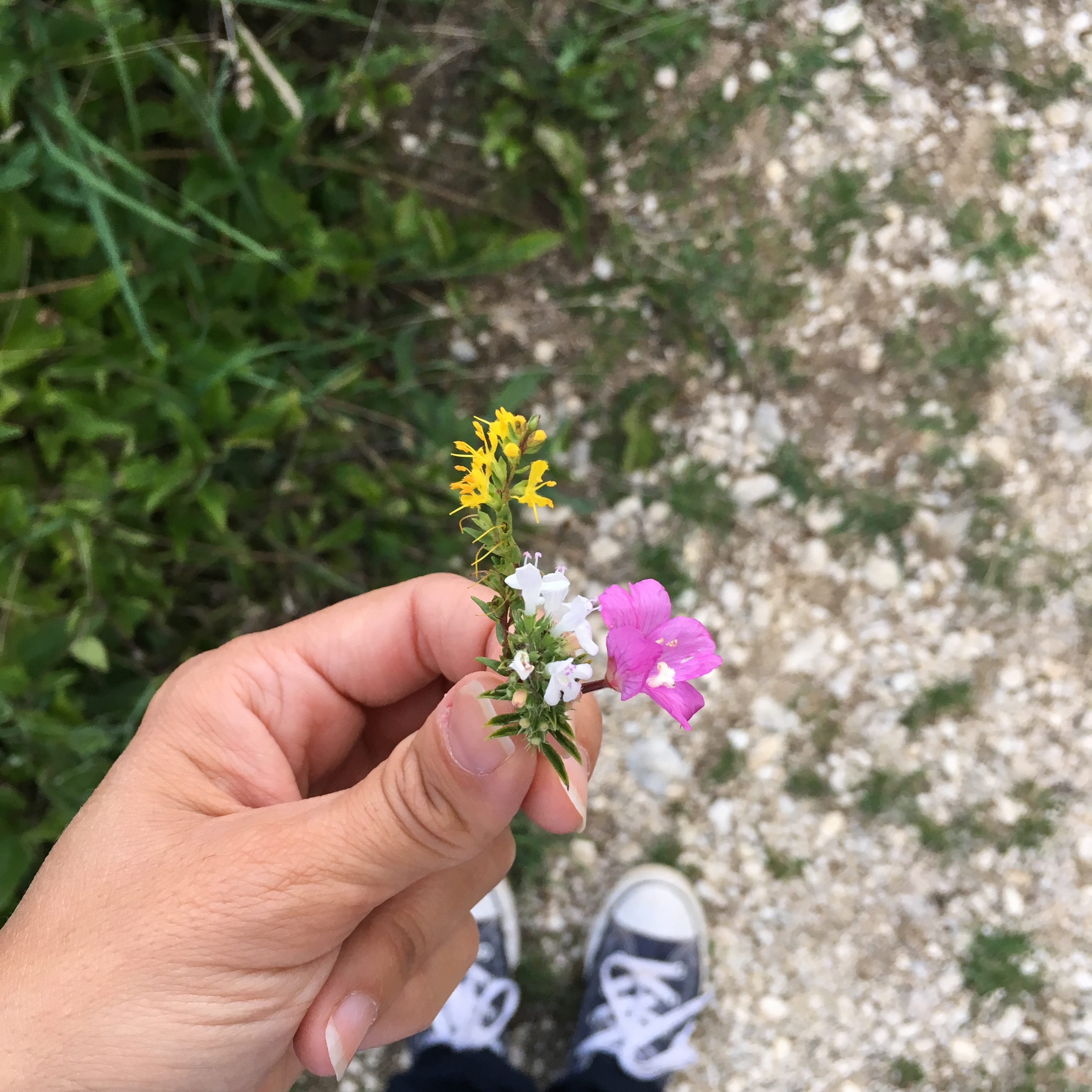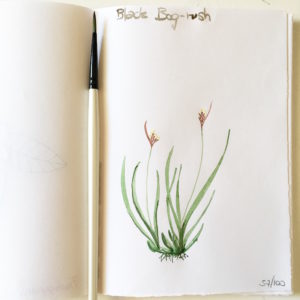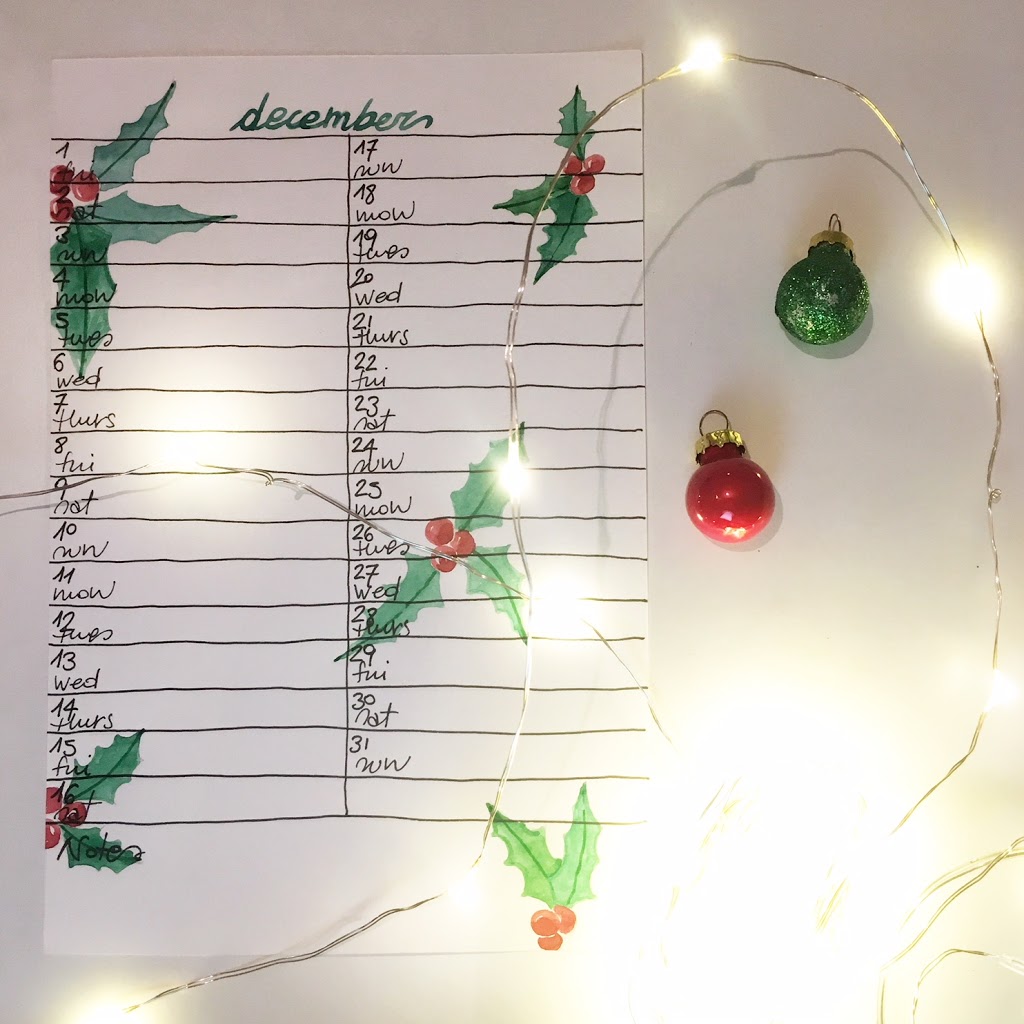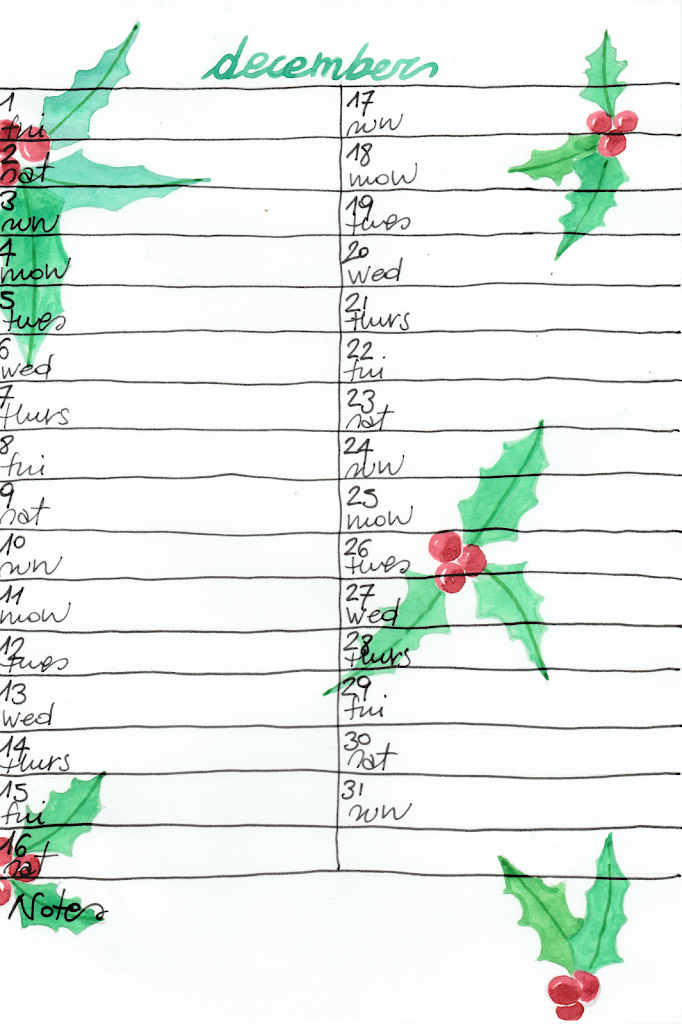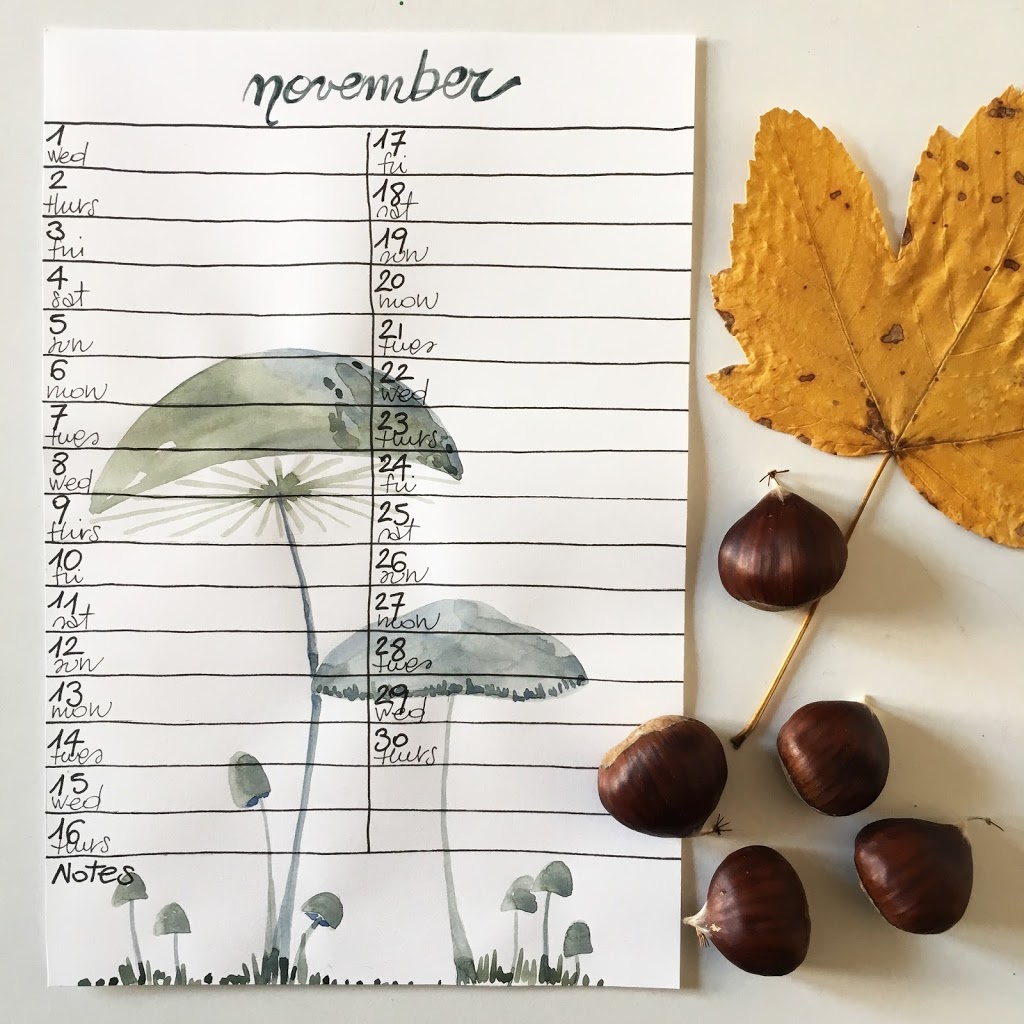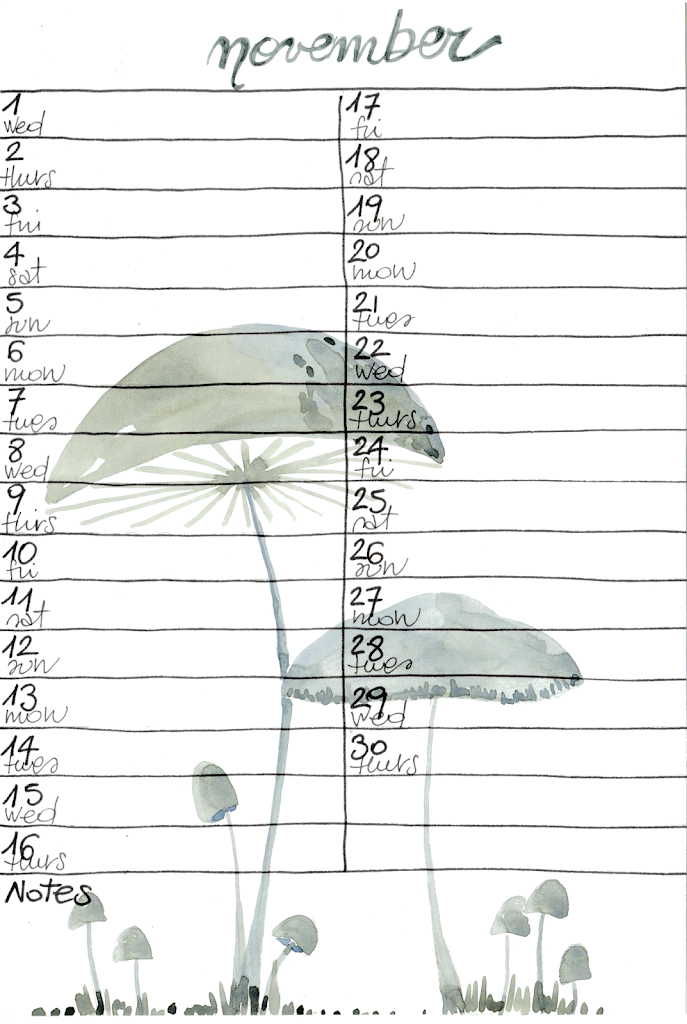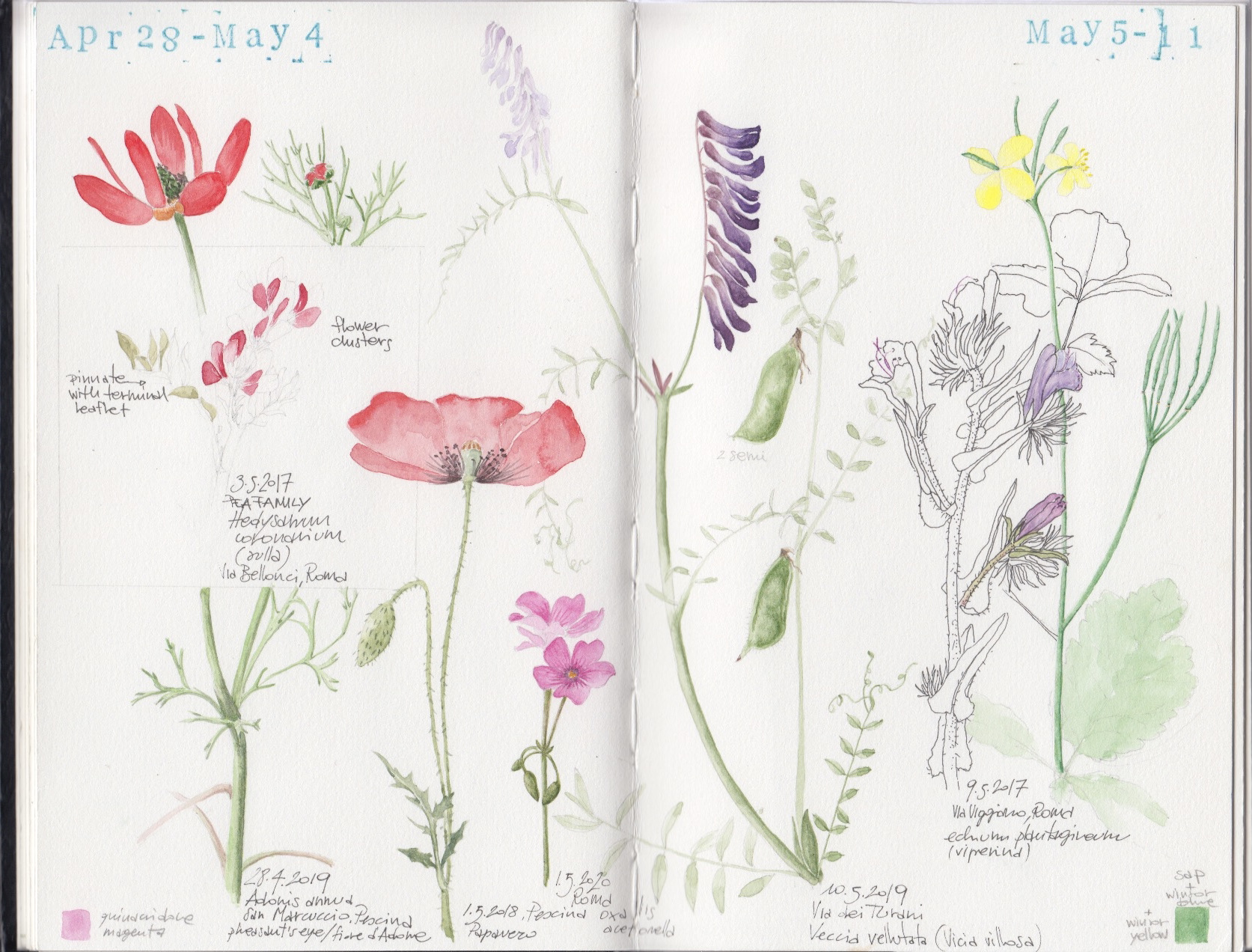
(English version below)
Riprendo a scrivere qui dopo tanto tempo per parlarvi del mio diario botanico. Chi mi segue su Instagram, avrà già avuto modo di vedere le mie annotazioni settimanali (#perpetualjournal_mc).
Ma oggi voglio riproporvelo qui, in maniera più completa, per incuriosirvi e spingervi magari ad iniziarne uno tutto vostro.
Quattro anni fa circa, il 3 gennaio 2017 per essere precisi, ho inaugurato un nuovo taccuino. Iniziare uno sketchbook nuovo ha sempre un qualcosa di magico, le pagine bianche, le aspettative, la pianificazione di cosa ci andrà, di quale sarà lo stile, il soggetto e una serie di problematiche che mi hanno portato nel tempo a lasciare bianca la prima pagina, ma che comunque spariscono non appena il colore si posa sul foglio.
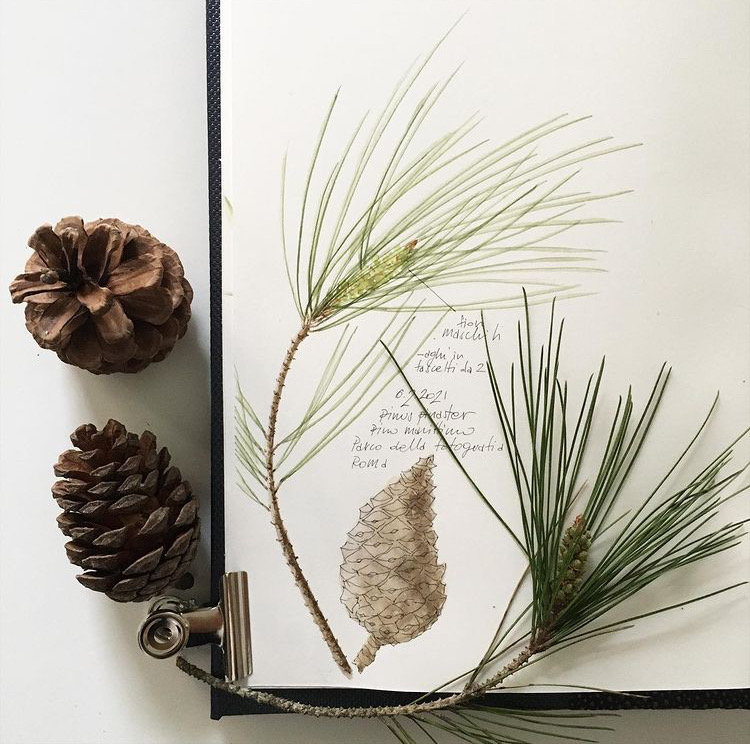 In quell’occasione cercavo un approccio diverso dal solito, qualcosa che lo rendesse omogeneo, ma anche che mi desse anche una certa libertà e soprattutto non fosse troppo impegnativo. Estasiata dal taccuino di Lara Gastinger, ho seguito il suo esempio e ho organizzato il mio sketchbook in modo da renderlo un diario perpetuo.
In quell’occasione cercavo un approccio diverso dal solito, qualcosa che lo rendesse omogeneo, ma anche che mi desse anche una certa libertà e soprattutto non fosse troppo impegnativo. Estasiata dal taccuino di Lara Gastinger, ho seguito il suo esempio e ho organizzato il mio sketchbook in modo da renderlo un diario perpetuo.
Che cos’è un diario perpetuo?
E’ in realtà un semplice taccuino con fogli bianchi che può essere usato per più anni consecutivi, finché ovviamente non finisce lo spazio sul foglio. Su ogni pagina (o ogni due) si inseriscono le settimane senza indicarne il giorno o l’anno (es. 1-7 Gen, 8-15 Gen, etc). Ogni settimana, di ogni anno, si annota sulla pagina corrispondente un appunto, nel mio caso uno schizzo a penna e acquarello di una pianta locale, prendendo nota del giorno, dell’anno, del posto e del nome della pianta. La prima settimana di gennaio dell’anno successivo si riparte aggiungendo una nuova nota nella pagina della settimana corrispondente (1-7 Gen), e così via.
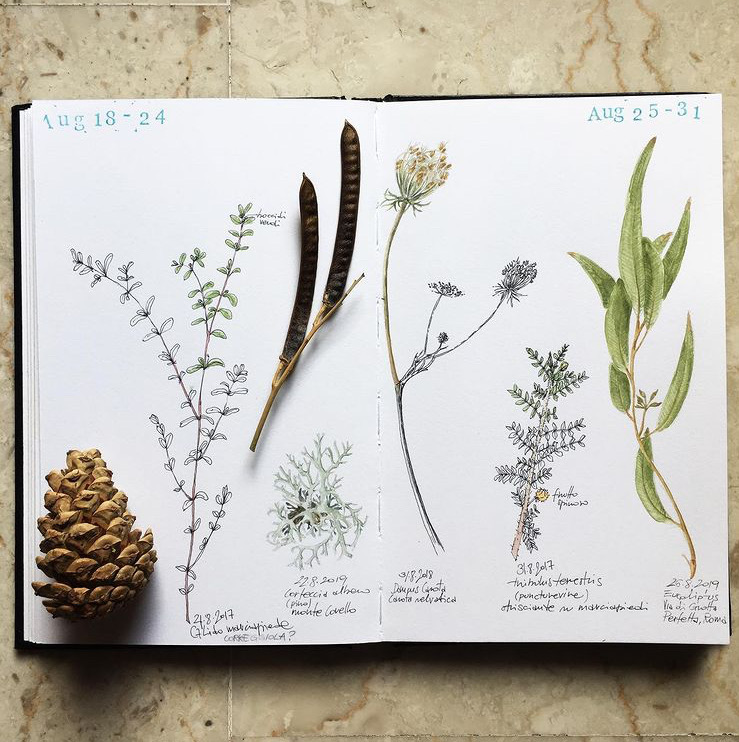 In questo modo si ottiene un diario che spazia su diversi anni; io sono già al quarto anno e al secondo taccuino.
In questo modo si ottiene un diario che spazia su diversi anni; io sono già al quarto anno e al secondo taccuino.
I materiali
Per il mio primo diario botanico ho usato un taccuino Stillman and Birn, serie Zeta formato A5 con copertina rigida. La carta è adatta all’acquarello botanico avendo una superficie molto liscia e una grammatura elevata (270gsm) che si presta anche a stesure di colore diluito.
Avendo a disposizione solo 52 pagine ho deciso di utilizzare una facciata per ogni settimana su cui ho stampato i giorni e il mese utilizzando dei semplici timbrini.
Il secondo taccuino, invece, non avendo avuto la possibilità di acquistarne un altro uguale, l’ho rilegato a mano, utilizzando carta satinata Studio Watercolour della Fabriano (grammatura 300gsm) e utilizzando le stesse dimensioni e numero di pagine di quello Stillman & Birn.
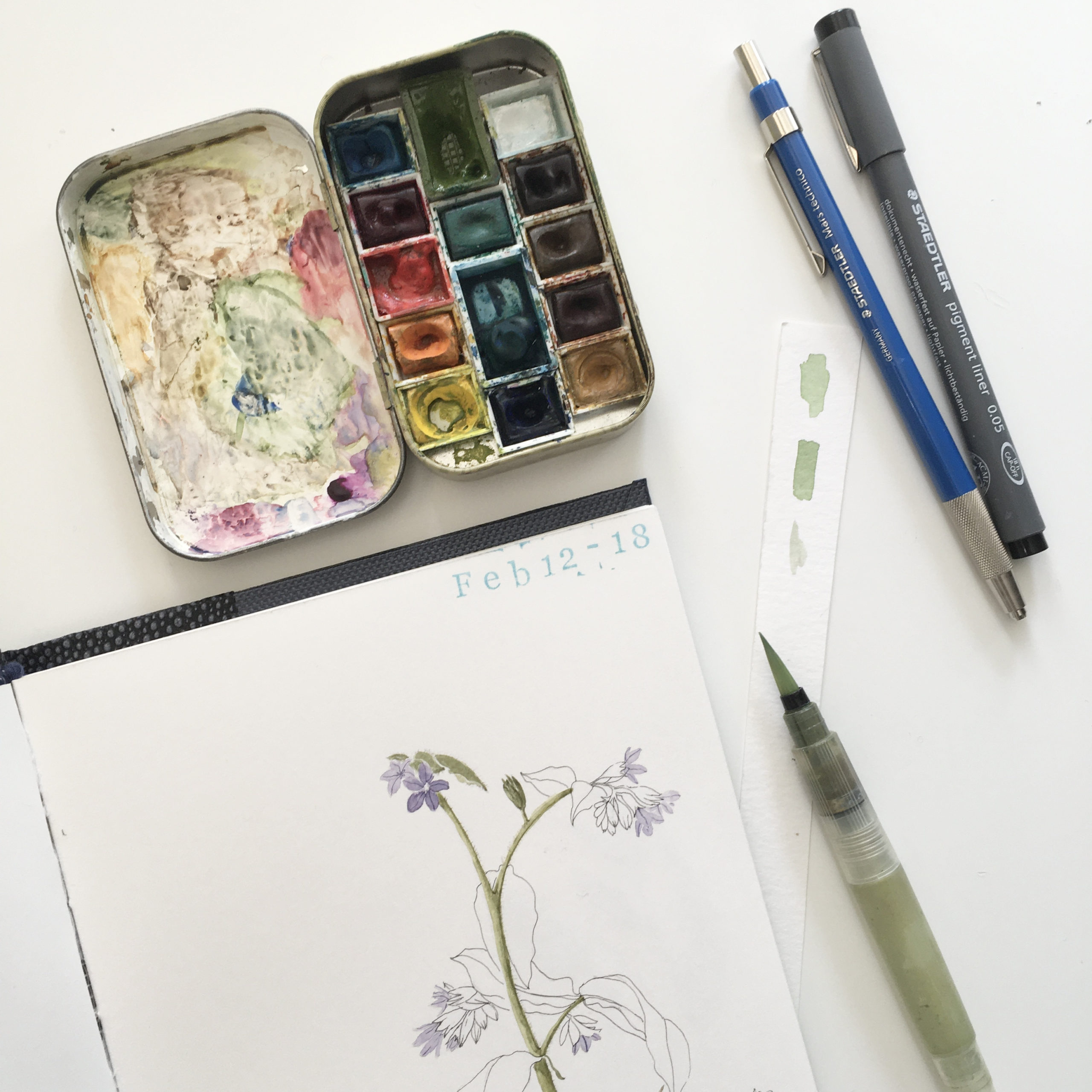 Per gli schizzi normalmente utilizzo una matita Faber-Castell 2H o HB, serie 9000, oppure una Staedtler Mars 2H, una penna nera Staedtler Fineliner da 0.05 mm oppure una Micron da 0.03 mm e acquerelli Winsor&Newton.
Per gli schizzi normalmente utilizzo una matita Faber-Castell 2H o HB, serie 9000, oppure una Staedtler Mars 2H, una penna nera Staedtler Fineliner da 0.05 mm oppure una Micron da 0.03 mm e acquerelli Winsor&Newton.
La scelta della palette è stata piuttosto casuale, nel senso che avevo già a disposizione un set da viaggio con un numero ridotto di colori; ho deciso quindi di continuare ad utilizzare ciò che avevo.
Difficilmente utilizzo altri materiali; questi sono quelli con cui mi sento più a mio agio e poi perché in questo modo lo stile risulta più compatto; preferisco sperimentare tecniche e materiali su altri taccuini.
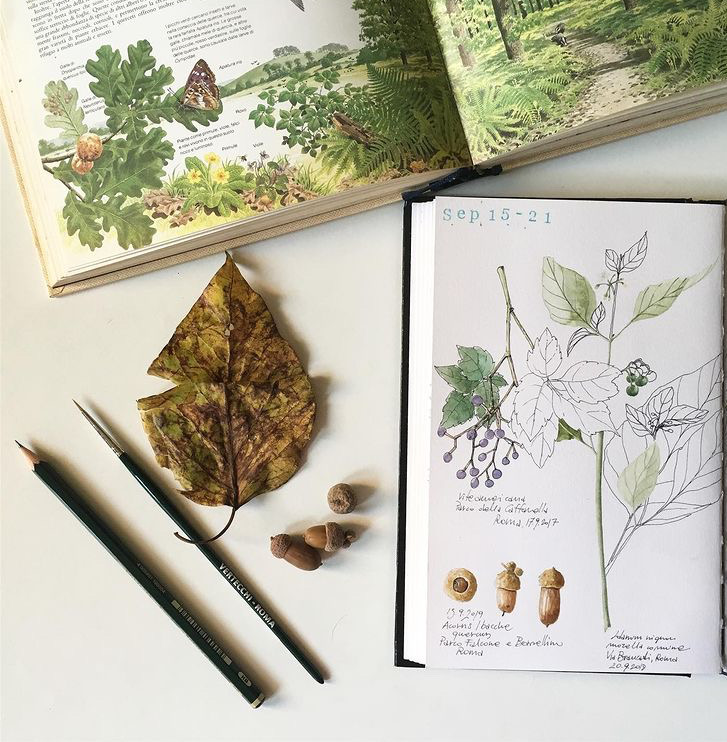
Il metodo
Non seguo regole particolari nel riportare le annotazioni; l’unico vincolo che mi sono data è che la specie botanica deve essere ritratta dal vero.
Con un due bimbi relativamente piccoli e un lavoro a tempo pieno, ho imparato col tempo ad approfittare di ogni momento a disposizione per osservare e annotare. Le mie annotazioni settimanali non sono affatto programmate; sono sempre alla ricerca di un soggetto che mi ispiri, ma appena lo trovo mi fermo a prendere appunti sul posto. Altre volte invece, se possibile, ne raccolgo un campione e lo porto a casa o in macchina o in ufficio…dipende dalla situazione.
Per quanto riguarda la composizione delle pagine, questa è una cosa che ho imparato ad apprezzare con il tempo. Il primo anno, avendo a disposizione un solo soggetto, è difficile pensare a come impaginare ogni settimana, ma già dal secondo anno questo aspetto emerge in maniera più evidente. L’accostamento delle forme, dei colori e delle tecniche si fa notare in maniera più marcata e, anche se è qualcosa che non sempre mi riesce, cerco di bilanciare il tutto.
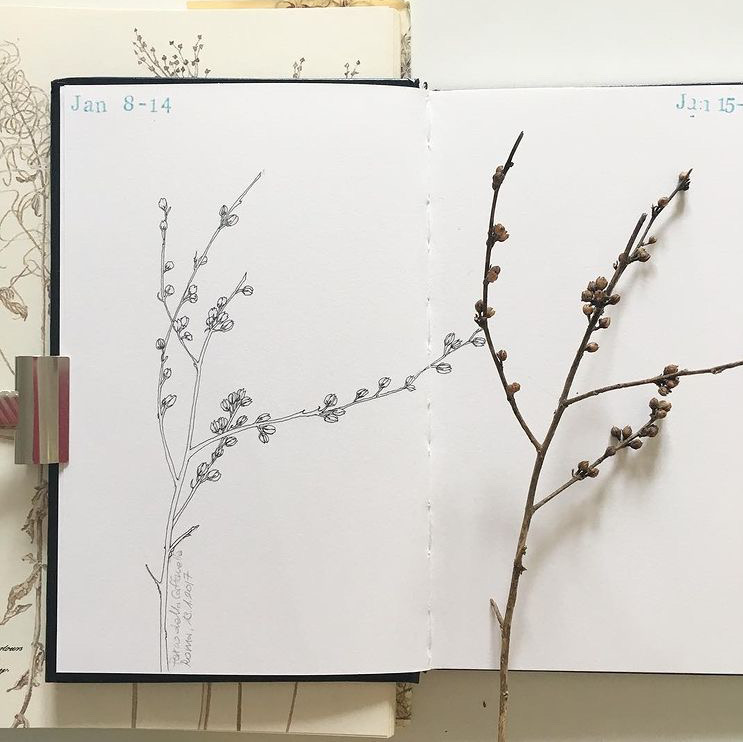
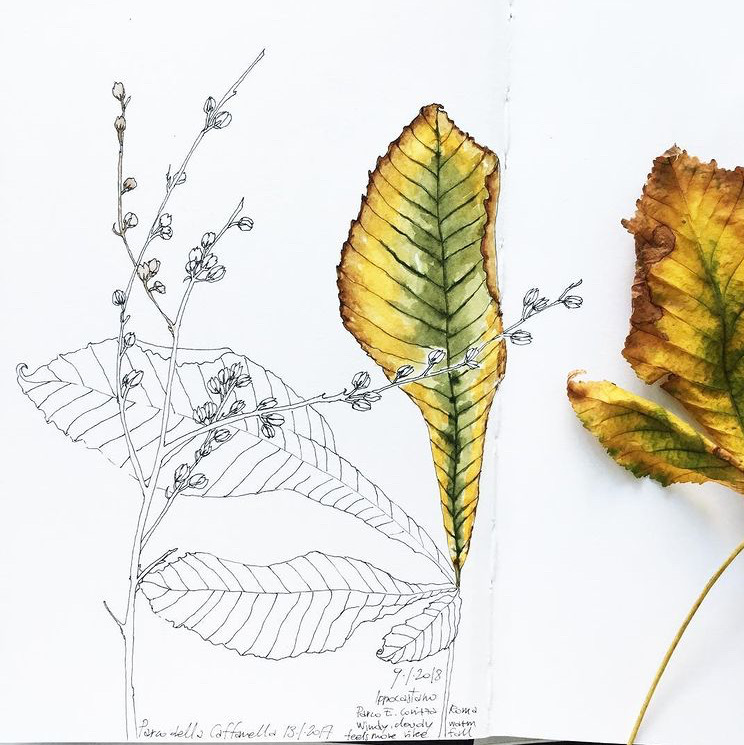
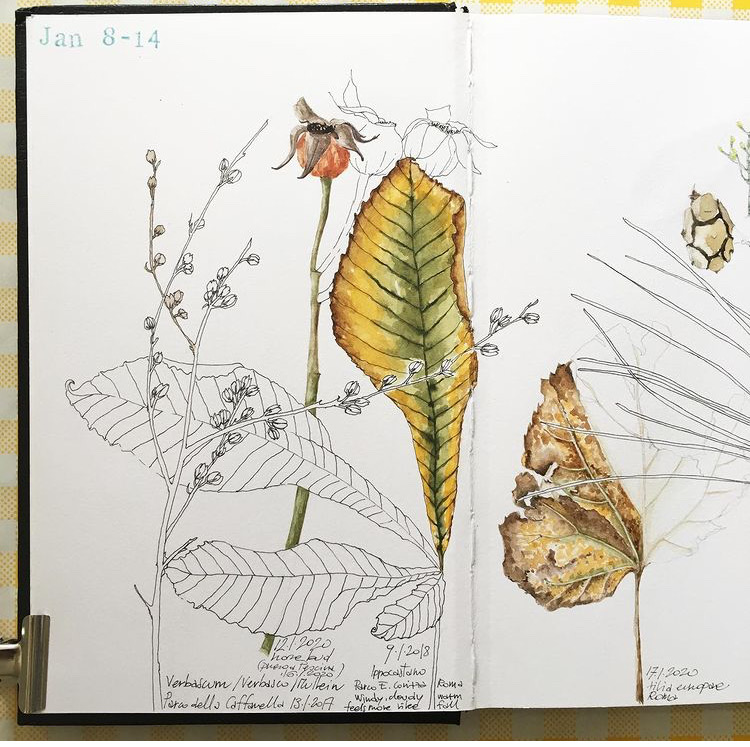
Fonti d’ispirazione
Nella città in cui vivo, le piante spontanee crescono ovunque e il clima mite permette di osservarle durante tutto l’anno. Forme e colori si susseguono con continuità e ogni stagione mostra le sue piante caratteristiche.
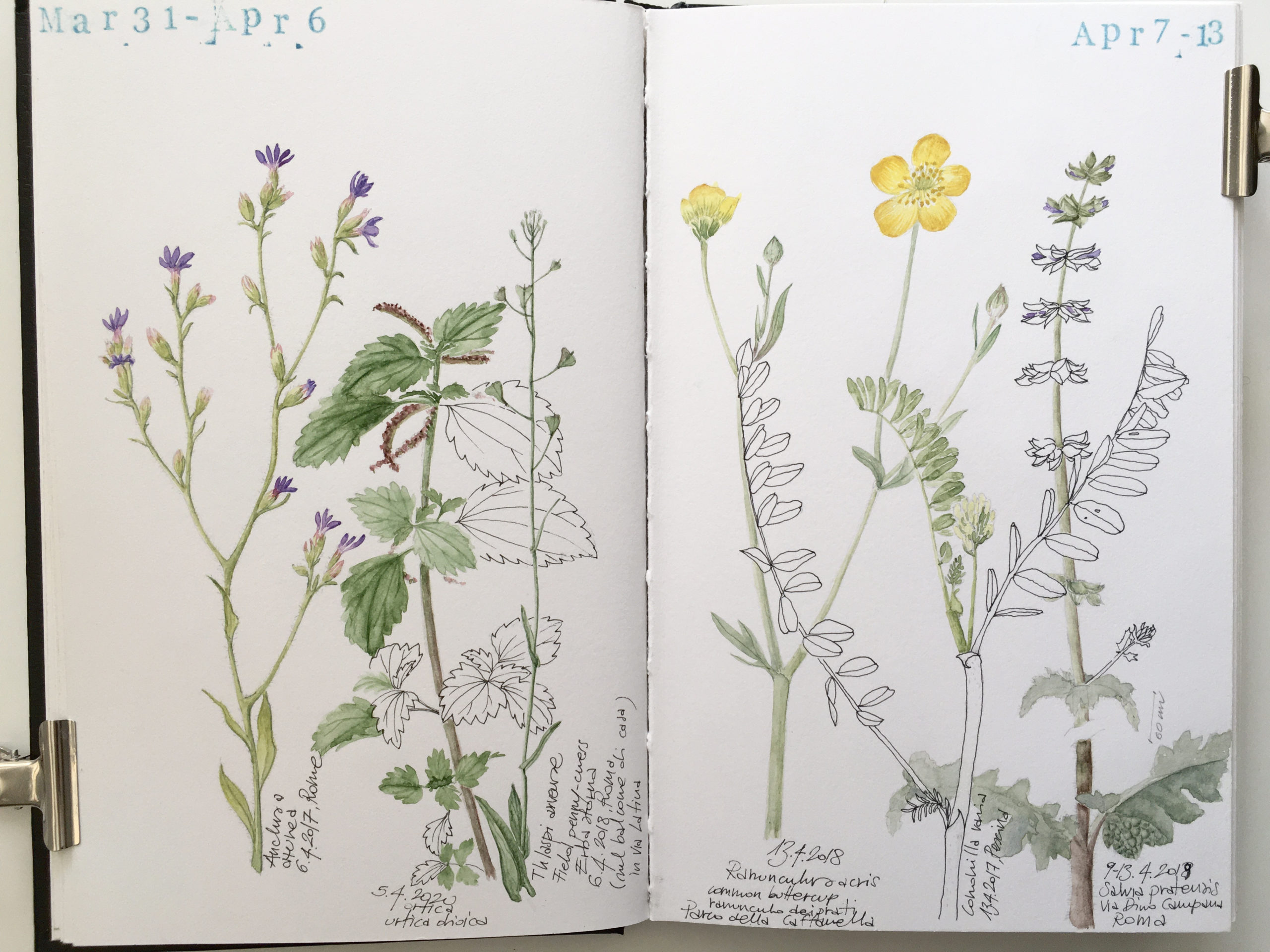 Ho imparato in questo modo ad apprezzare anche quelle piante considerate invasive, le cosiddette “erbacce da marciapiede”; ogni pianta nasconde la sua peculiarità e bellezza, basta osservarla da vicino e a volte separarla dal contesto in cui cresce.
Ho imparato in questo modo ad apprezzare anche quelle piante considerate invasive, le cosiddette “erbacce da marciapiede”; ogni pianta nasconde la sua peculiarità e bellezza, basta osservarla da vicino e a volte separarla dal contesto in cui cresce.
Mi piace riguardare di anno in anno le mie annotazioni e ripensare al luogo e al momento; mi piace ricercare i nomi delle piante che osservo e studiarne le caratteristiche. E ogni anno ripercorro e arricchisco questo diario.
Se volete saperne di più vi suggerisco il profilo Instagram di Lara Gastinger @laragastinger e la sua intervista per Kristin Link (http://kristinillustration.com/blog/2017/11/29/lara-call-gastingers-perpetual-journal) in cui vi parla del suo nature journal.
![]()
![]()
My nature journal
I’m coming back to this space after a long hiatus to introduce you to my botanical journal. If you follow me on Instagram you have probably seen my weekly journal entries (#perpetualjournal_mc).
But today I want to talk about it again here, in more detail, to intrigue you and perhaps inspire you to start your own.
About four years ago, on January 3, 2017 to be precise, I started a new journal. Starting a new sketchbook always has something magical, blank pages, expectations, planning what will go there, what will be the style, the subject and a series of anxieties that have led me over time to leave the first page blank, but which disappear as soon as the colors settle on the sheet.
At that time, I was looking for a different approach, something that would make the journal looks cohesive, but that would also give me a certain freedom and, most of all, that wasn’t too demanding. Inspired by Lara Gastinger’s perpetual journal, I followed her example and organized my sketchbook to make it a perpetual diary.
So, what’s a perpetual journal?
It’s basically a blank journal where you mark each week of the year (1-7 Jan, 8-15 Jan, etc) without entering the day nor the year. Every week, of any given year, you record something on that page (a wildplant related sketch in my case) adding the date and some notes and you keep going this way until you have no more space left on the page. So to speak, on January first of the following year you’ll be adding another entry on the page marked 1-7 Jan, and so on. What you’ll end up with is a journal covering several years. I’m on year four now and on my second journal.
It’s a nice way to make the habit of recording nature every week without feeling bad if you miss a week!
Materials
For my first perpetual journal I used an A5 Stillman and Birn zeta series sketchbook with a hard cover. The paper is smooth and heavy, suitable for botanical work.
Because the sketch book has 52 pages, I decided to use one side for each week. Each side has been stamped with the days and month.
For my second sketchbook, I couldn’t get a Stillman & Birn, so I made my own journal using hot pressed Studio Watercolour paper by Fabriano and following the size and number of pages of my previous journal.
For sketching I have been using mainly a 2H or HB pencil from Faber-Castell 9000 or a 2H Staedler Mars, a black 0.05mm Staedler fineliner or a 0.03mm Micron pen and Winsor&Newton artists’ watercolours. The colour palette I use was not really by choice; when I started my first journal, I was using a handmade palette as part of my travel kit and decided to keep using what was available back then.
I tend not to use anything else, as I feel much confident with the tools above and the overall style looks more cohesive.
Process
I don’t follow specific rules on my diary, as long as the subject is drawn from real life.
Between work and family, I’ve learned with time to take advantage of any given moment to observe and record. My weekly entries are not scheduled; I’m always looking for something inspiring and when I find it, I either take notes on the spot or, if alloed, I take a sample and bring it home, or in the car, or to the office…depending on the situation.
Page composition has also become an important aspect of the journal. The first year was not an issue, as I only had one subject to deal with. But now that I’m on year four the layout on each spread is something I try to take into consideration.
Inspirations
In my city, wildflowers grow everywhere and at any time of year; every season has something new and intersting to offer.
I’ve learned to consider weeds as wildflowers, especially everything that grows on sidewalks becomes interesting and beautiful in its own way.
I love looking at my entries from the past year and think about the time and place it was taken; I love finding the name of the plants and studying everything about them. And every year I add something new.
If you want to know more about how to start a perpetual journal and get weekly inspiration, make sure to follow Lara Gastinger on IG (@laragastinger) and read her interview on Kristin Link website (http://kristinillustration.com/blog/2017/11/29/lara-call-gastingers-perpetual-journal)
